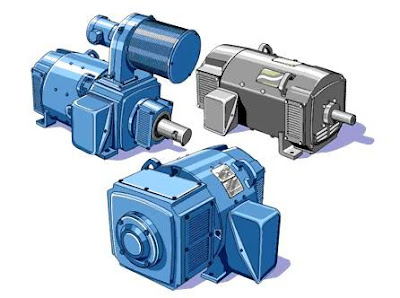Types of DC Motor | Application And Drawbacks

Today, I will explain the different types in electric motors world as follows.
Main Types of Motor
Electric motors are broadly classified into two categories as follows:
- AC Motors.
- DC Motors.
Motor Types
Notes: Recently, with the development of economical and reliable power electronic components, there are numerous ways to design a motor and the classifications of these motors have become less rigorous and many other types of motor have appeared. Our classification of motors will be comprehensive as can as possible.
First: DC motors
DC motors
DC power systems are not very common in the contemporary engineering practice. However, DC motors have been used in industrial applications for years Coupled with a DC drive, DC motors provide very precise control DC motors can be used with conveyors, elevators, extruders, marine applications, material handling, paper, plastics, rubber, steel, and textile applications, automobile, aircraft, and portable electronics, in speed control applications.
Advantages of DC motors:
It is easy to control their speed in a wide range; their torque-speed characteristic has, historically, been easier to tailor than that of all AC motor categories. This is why most traction and servo motors have been DC machines. For example, motors for driving rail vehicles were, until recently, exclusively DC machines.
Their reduced overall dimensions permit a considerable space saving which let the manufacturer of the machines or of plants not to be conditioned by the exaggerated dimensions of circular motors.
Disadvantages of DC motors
Since they need brushes to connect the rotor winding. Brush wear occurs, and it increases dramatically in low‐pressure environment. So they cannot be used in artificial hearts. If used on aircraft, the brushes would need replacement after one hour of operation.
Sparks from the brushes may cause explosion if the environment contains explosive materials.
RF noise from the brushes may interfere with nearby TV sets, or electronic devices, Etc.
DC motors are also expensive relative to AC motors.
Thus all application of DC motors have employed a mechanical switch or commutator to turn the terminal current, which is constant or DC, into alternating current in the armature of the machine. Therefore, DC machines are also called commutating machines.
Types of DC motors:
The DC motors divide in mainly to:
Brush DC motors (BDC).
Brushless DC motors (BLDC).
1. A Brush DC motors
Brush DC motors
A brushed DC motor (BDC) is an internally commutated electric motor designed to be run from a direct current power source.
Applications:
Brushed DC motors are widely used in applications ranging from toys to push-button adjustable car seats.
Advantages:
Brushed DC (BDC) motors are inexpensive, easy to drive, and are readily available in all sizes and shapes
Construction:
Brushed DC motor Construction
All BDC motors are made of the same basic components: a stator, rotor, brushes and a commutator.
1- Stator
The stator generates a stationary magnetic field that surrounds the rotor. This field generate by either permanent magnets or electromagnetic windings.
2- Rotor
The rotor, also call an armature, is made up of one or more windings. When these windings energize they produce a magnetic field. The magnetic poles of this rotor field will attract to the opposite poles generates by the stator, causing the rotor to turn. As the motor turns, the windings are constantly being energize in a different sequence so that the magnetic poles generates by the rotor do not overrun the poles generate in the stator. This switching of the field in the rotor windings call commutation.
3- Brushes and Commutator
Unlike other electric motor types (i.e., brushless DC, AC induction), BDC motors do not require a controller to switch current in the motor windings. Instead, the commutation of the windings of a BDC motor is mechanically. A segmented copper sleeve, called a commutator, resides on the axle of a BDC motor. As the motor turns, carbon brushes (ride on the side of the commutator to provide supply voltage to the motor) slide over the commutator, coming in contact with different segments of the commutator. It is important to note that the brushes and commutator are the parts of a BDC motor that are most prone to wear because they are sliding past each other.
How the Commutator Works:
As the rotor turns, the commutator terminals also turn and continuously reverse polarity of the current it gets from the stationary brushes attached to the battery.
Types of BDC motors:
The different types of BDC motors distinguish by the construction of the stator or the way the electromagnetic windings connect to the power source.
These types are:
- Permanent Magnet.
- Shunt-Wound.
- Series-Wound.
- Compound-Wound.
- Separately excited DC motor.
- Universal Motor.
- Servo Motors.
Permanent Magnet Motor
A permanent magnet DC (PMDC) motor is a motor whose poles are made out of permanent magnets to produce the stator field.
Advantages:
- Since no external field circuit need, there are no field circuit copper losses.
- Since no field windings need, these motors can be considerable smaller.
- Widely use in low power application.
- Field winding replace by a permanent magnet (simple construction and less space).
- No requirement on external excitation.
Disadvantages:
- Since permanent magnets produces weaker flux densities then externally supported shunt fields, such motors have lower induced torque.
- There is always a risk of demagnetization from extensive heating or from armature reaction effects (Some PMDC motors have windings built into them to prevent this from happening).
Shunt-Wound Motor
Shunt-wound Brushed DC (SHWDC) motors have the field coil in parallel (shunt) with the armature.
The speed is practically constant independent of the load and therefore suitable for commercial applications with a low starting load, such as centrifugal pump, machine tools, blowers fans, reciprocating pumps, etc.
Advantages:
- The current in the field coil and the armature are independent of one another. as a result, these motors have excellent speed control.
- Loss of magnetism is not an issue in SHWDC motors so they are generally more robust than PMDC motors.
- Speed can control by either inserting a resistance in series with the armature (decreasing speed) or by inserting resistance in the field current (increasing speed).
Disadvantages:
- Shunt-wound Brush DC (SHWDC) motors have drawbacks in reversing applications, however, because winding direction relative to the shunt winding must reverse when armature voltage is reverse. Here, reversing contactors must use.
Series-Wound Motor
Series-wound Brushed DC (SWDC) motors have the field coil in series with the armature. These motors ideally suits for high-torque applications such as traction vehicles (cranes and hoists, electric trains, conveyors, elevators, electric cars) because the current in both the stator and armature increases under load.
Advantages:
The torque is proportional to I2 so it gives the highest torque per current ratio over all other dc motors.
Disadvantages:
- A drawback to SWDC motors is that they do not have precise speed control like PMDC and SHWDC motors have.
- Speed restrict to 5000 RPM.
- It must avoids to run a series motor with no load because the motor will accelerate uncontrollably.
Compound-Wound Motor
Compound Wound (CWDC) motors are a combination of shunt-wound and series-wound motors.
CWDC motors employ both a series and a shunt field. The performance of a CWDC motor is a combination of SWDC and SHWDC motors. CWDC motors have higher torque than a SHWDC motor while offering better speed control than SWDC motor.
It uses in Applications such as Rolling mills, sudden temporary loads, heavy machine tools, punches, etc.
Advantages:
This motor has a good starting torque and a stable speed.
Disadvantages:
The no-load speed is controllable unlike in series motors.
Separately excited DC motor
In a separately excited DC motor the field coils supply from an independent source, such as a motor-generator and the field current unaffecting by changes in the armature current. The separately excited DC motor was sometimes used in DC traction motors to facilitate control of wheel slip.
Universal Motor
The universal motor is a rotating electrical machine similar to DC series motor, designed to operate either from AD or DC source. The stator & rotor windings of the motor are connected in series through the rotor commutator. The series motor design to move large loads with high torque in applications such as crane motor or lift hoist.
Servo Motors
Servo Motors are mechanical devices that instruct to move the output shaft attached to a servo wheel or arm to a specified position. They design for applications involving position control, velocity control and torque control.
Servo Motors Components
A servo motor mainly consists of a DC motor, gear system, a position sensor which is mostly a potentiometer, and control electronics.



